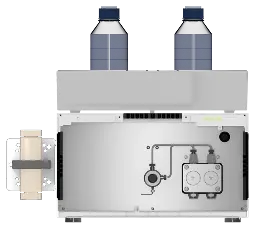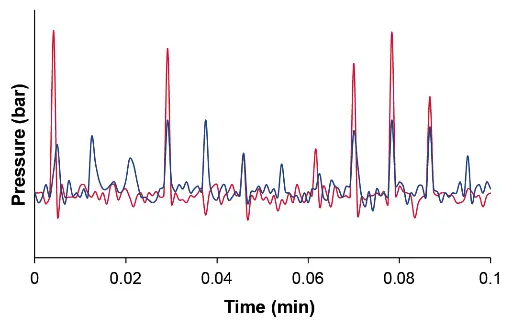
Science with Passion
Application No.: VTN0022 Version 1 09/2021
Reduce pulsation – improve performance and increase longevity of your column using the pulse damper with the AZURA® P 2.1L
Johannes Menke, Florian Glauche, Kate Monks; applications@knauer.net
KNAUER Wissenschaftliche Geräte GmbH, Hegauer Weg 38, 14163 Berlin

Rendering: KNAUER
Summary
When working with preparative liquid chromatography (LC) pumps such as the AZURA P 2.1L some degree of pressure pulsation is to be expected, due to the operating principles of piston pumps. Although the P 2.1L is equipped with active pulsation compensation, residual pulsation cannot be prevented. Residual pulsation is generally not an issue but for certain applications, such as precise dosing or when working with sensitive columns, it can be problematic. Integration of the KNAUER PEEK Pulse Damper into the LC system can mitigate the pump’s pressure pulsation. In the conducted experiments the effect of the pulse damper was most visible with high flow rates up to 100 ml/min.
Introduction
Liquid chromatography (LC) pumps usually operate following the double piston principle. Two alternating pistons move as counterparts in the pump head to create a continuous flow of eluent. The pressure profile in the pump varies depending on the momentary position of the pistons in the operating cycle of the pumps drive. Although pressure fluctuations can be reduced through optimization of the piston velocity profile based on the compressibility of the fluid, pulsation cannot be fully prevented. This residual pulsation is usually not an issue when working within LC and can therefore be ignored in most cases. However, in certain applications pump pulsation cannot be ignored. Examples of such cases include when working with pressure sensitive stationary phase materials, in precise dosing applications, membrane filtration, as well as applications where detector baseline noise can be led back to pump pulsation. For these applications integration of the KNAUER PEEK Pulse Damper into the system can be a viable option.
The pulse damper is usually integrated into the flow path after the purge valve and before the injection unit. The pulse damper provides extra volume and disruptive fluidic behaviour to minimize pressure spikes originating from the pump piston movement. This effectively reduces the negative effects of pressure spikes for any downstream component in the system flow path. Sensitive LC columns benefit from this feature since their overall lifetime is increased. Especially column beds (e.g., crosslinked copolymer phases such as KNAUER Eurokat, or FPLC columns) that cannot compensate easily for repeated pressure impacts would benefit greatly from the use of a pulse damper. In precise dosing applications a pressure spike, although not visible with the naked eye, might cause issues. The integration of a pulse damper can decrease these spikes and therefore result in a more stable and reproducible dosing process. When detector baseline noise stability is an issue, a possible cause can be pump pulsation. This is for instance a common issue with refractive index detectors, especially when used in combination with solvents with a low compressibility. The detectors reference cell is not exposed to the pump pulsation whereas the measuring cell of the detector is, being one cause for baseline noise. The use of a pulse damper in this case will lead to a decrease in baseline noise.
Results
Different flow rates from 10 up to 100 ml/min were evaluated both with and without a pulse damper, and a total of 10 measuring points were acquired. The raw pressure trace of the secondary sensor was recorded at a frequency of 20 Hz for 1 to 2 min. For evaluation a time frame of 0.1 min in the mid of signal was chosen. Within that time frame the 5 minimum and maximum pressure values were determined. Average and standard deviation of minima (SDmin) and maxima (SDmax) were calculated. From the amount of the averages of minima and maxima, the pressure amplitude (∆p) was determined. The measurement value equals to ∆p + SDmax – SDmin. At all tested flow rates, the pulsation dampening was significant when a pulse damper was used (Fig. 1). The best results were achieved at higher flow rates from 70 to 100 ml/min (Fig. 2).

Fig. 1 Effect of pulse damper on pressure amplitude; red – without pulse damper; blue with pulse damper; flow rate 80 ml/min

Fig. 2 Average pulsation dampening at flow rates of 10 to 100 ml/min ± relative standard deviation (RSD)
Conclusion
The use of a pulse damper can be recommended for the AZURA P 2.1L in isocratic mode up for flowrates up to 100 ml/min. The additional back pressure created by the device was insignificant at all tested flow rates. Whenever a reduced level of pump pulsation is required a pulse damper should be integrated into the system (Fig. 3).

Fig. 3 Integration of a pulse damper in a typical preparative LC-System

Fig. 4 Test Setup
Material and Methods
To test the pulse damper, it was installed directly after the purge valve of an isocratic AZURA P 2.1L with a 250 ml stainless steel pump head. A manual 6-port 2-position valve was used to switch between the pulse damper and a bypass (Fig. 4). A secondary pressure sensor was installed directly after the pulse damper, so that the effect of the pulse damper became observable. At the end of the system a back pressure regulator was installed to create a measurable system pressure. All parts were conjoined using 1 mm ID PEEK capillaries. Water was used as eluent.
Tab. 1 Method parameters
Method parameter | |
Eluent | Water |
Flow rate | 10; 20; 30; 40; 50; 60; 70; 80; 90; 100 ml/min |
Detection | External pressure sensor |
Data rate | 20 Hz |
Temperature | Ambient |
System configuration
Tab. 2 System and devices are used
Instrument | Description | Article No. |
Pump | AZURA P 6.1L | |
Secondary Pressure Sensor | AZURA P 4.1S Pressure Sensor | |
Pulse Damper | Pulse Damper, High Volume, PEEK | |
Valve | Manual Injection Valve, 6 Port 2 Position, 1/16" | |
Back-Pressure Regulator | Back-Pressure Regulator 20–103 bar | A70088 |
Capillaries | 1 mm ID Peek | |
Software | KNAUER K-Pumptool | n.a. |
Related KNAUER Applications
VTN0019 – Reduce pulsation – improve performance and increase longevity of your column using the pulse damper with the AZURA® SEC FPLC System
VTN0020 – Evaluation of a pulse damper for FPLC systems with a P 6.1L pump
Application details
|
Method |
Preparative HPLC |
|
Mode |
RP |
|
Substances |
n/a |
|
CAS number |
n/a |
|
Version |
Application No.: VTN0022 | Version 1 09/2021 | ©KNAUER Wissenschaftliche Geräte GmbH |


